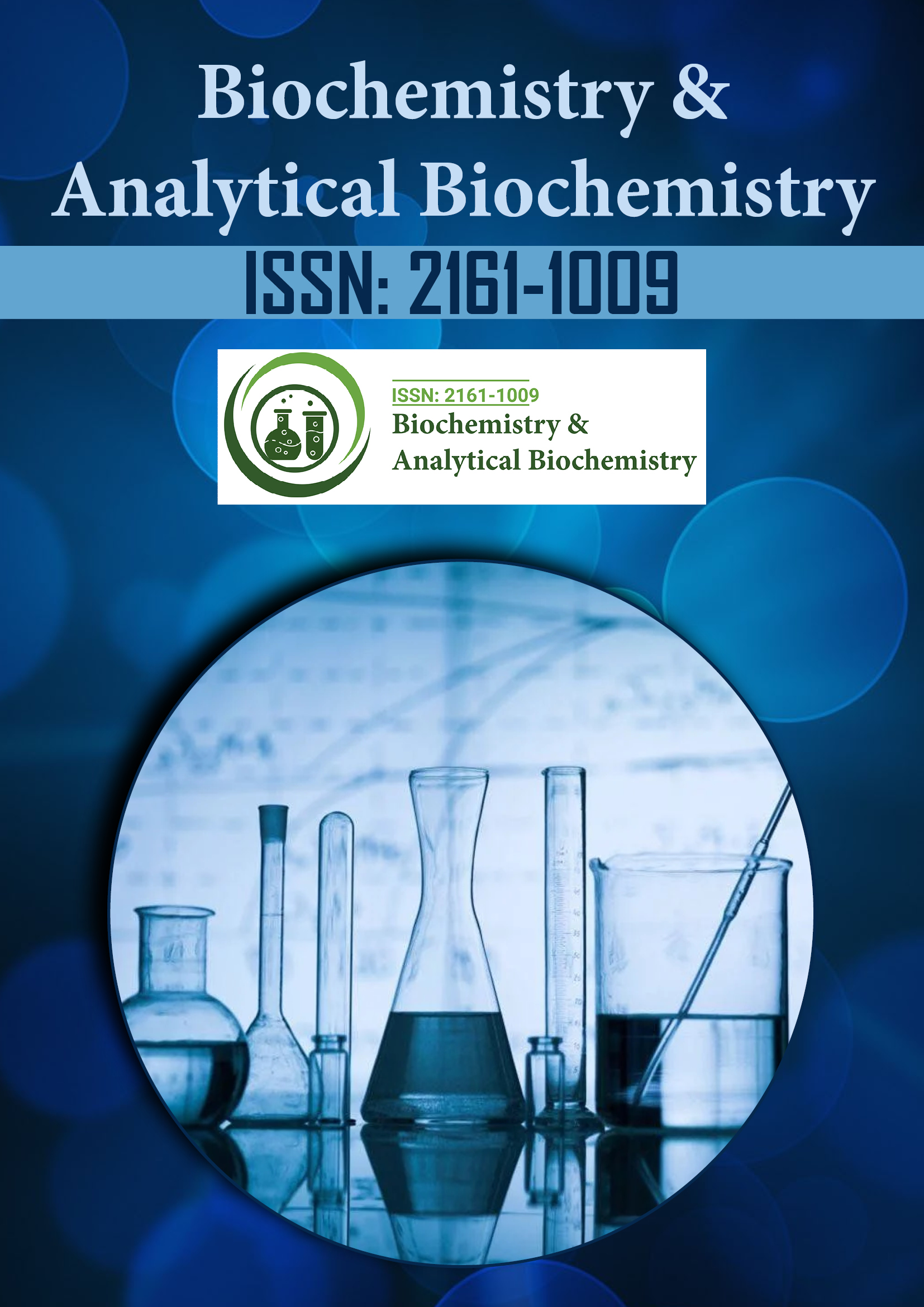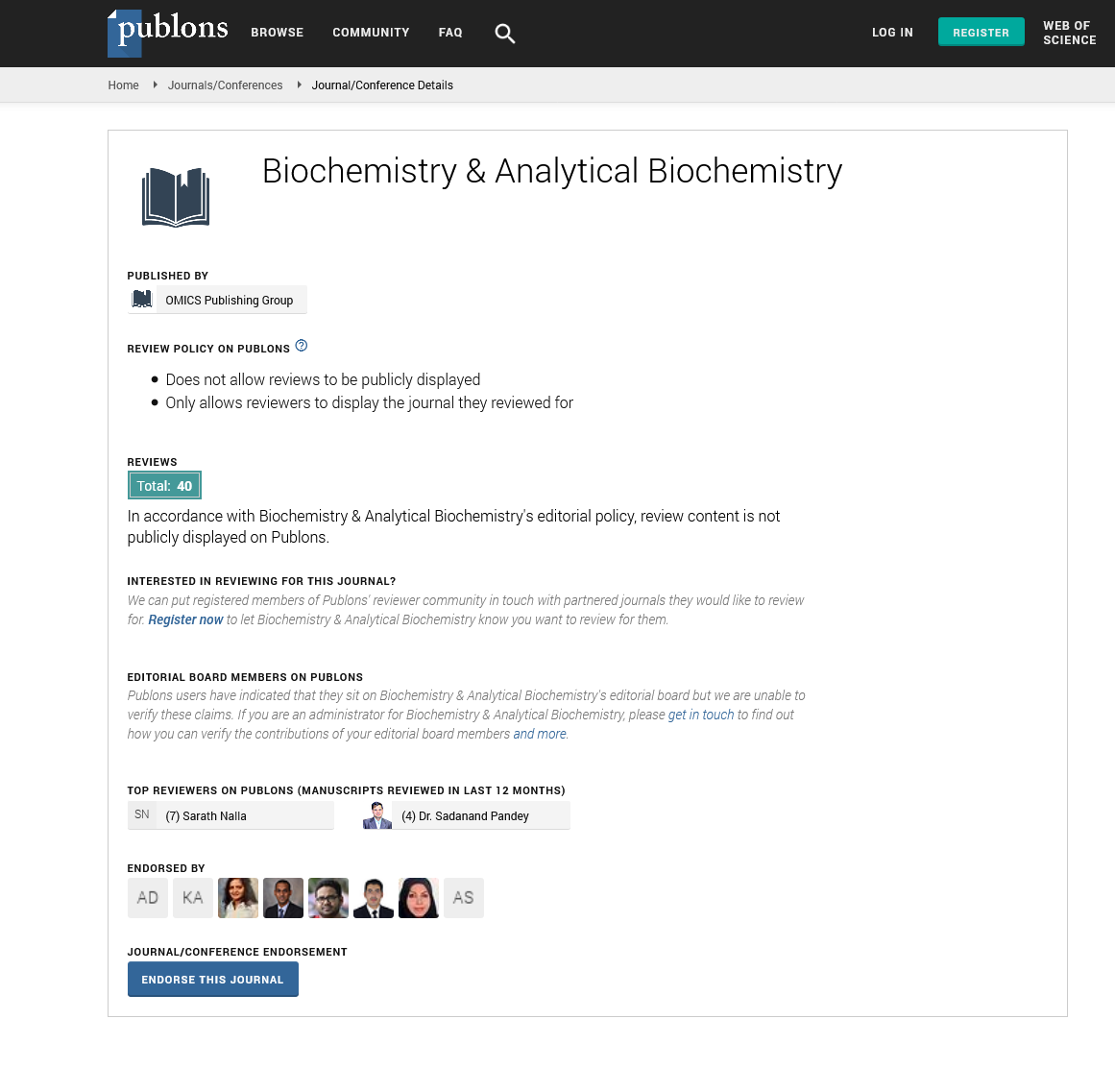Indexed In
- Open J Gate
- Genamics JournalSeek
- ResearchBible
- RefSeek
- Directory of Research Journal Indexing (DRJI)
- Hamdard University
- EBSCO A-Z
- OCLC- WorldCat
- Scholarsteer
- Publons
- MIAR
- Euro Pub
- Google Scholar
Useful Links
Share This Page
Journal Flyer

Open Access Journals
- Agri and Aquaculture
- Biochemistry
- Bioinformatics & Systems Biology
- Business & Management
- Chemistry
- Clinical Sciences
- Engineering
- Food & Nutrition
- General Science
- Genetics & Molecular Biology
- Immunology & Microbiology
- Medical Sciences
- Neuroscience & Psychology
- Nursing & Health Care
- Pharmaceutical Sciences
Perspective - (2024) Volume 13, Issue 4
Bioanalytical Techniques in Enzyme Kinetics: Exploring Mechanisms and Therapeutic Potential
Laura Cheng*Received: 27-Nov-2024, Manuscript No. BABCR-24-28129; Editor assigned: 29-Nov-2024, Pre QC No. BABCR-24-28129 (Pq); Reviewed: 13-Dec-2024, QC No. BABCR-24-28129; Revised: 20-Dec-2024, Manuscript No. BABCR-24-28129 (R); Published: 27-Dec-2024, DOI: 10.35248/2161-1009.24.13.562
Description
Bioanalytical approaches to understanding enzyme function and kinetics have significantly advanced ability to study the dynamic behavior of enzymes and their roles in biochemical reactions. Enzymes, as biological catalysts, play a key role in regulating metabolic pathways, maintaining cellular homeostasis, and supporting virtually every biochemical process in living organisms. The ability to analyze enzyme function and determine their kinetic properties is essential for understanding their biological significance, investigating disease mechanisms, and developing therapeutic strategies. Bioanalytical techniques, which combine experimental methods with analytical tools, offer powerful ways to investigate enzyme behavior at molecular and cellular levels.
Enzyme kinetics, which involves the study of the rates of enzymecatalyzed reactions, provides insights into how enzymes interact with substrates, co-factors, and inhibitors. Traditional approaches for studying enzyme kinetics rely on measuring reaction rates under varying substrate concentrations to determine key kinetic parameters such as the Michaelis constant (Km) and maximum velocity (Vmax). These parameters offer valuable information about the affinity of an enzyme for its substrate and the efficiency of the catalytic process. Bioanalytical methods, such as spectrophotometry and fluorometry, are commonly used to monitor the progress of enzyme-catalyzed reactions in real-time by detecting changes in absorbance or fluorescence that correspond to product formation or substrate consumption.
One of the most powerful bioanalytical tools for studying enzyme function is High-Performance Liquid Chromatography (HPLC). HPLC allows for the precise separation of reaction products and substrates, making it possible to quantify enzyme activity and determine reaction kinetics. By analyzing the concentration of substrates and products over time, researchers can calculate reaction rates and identify factors that influence enzyme performance. For example, HPLC has been used extensively to study the kinetics of enzymes involved in drug metabolism, where it is essential to understand how enzymes interact with pharmaceutical compounds and how these interactions affect drug efficacy and toxicity.
Mass Spectrometry (MS) is another advanced bioanalytical technique that has revolutionized enzyme analysis by enabling the identification and characterization of enzyme substrates, products, and post-translational modifications. MS can be used to determine the molecular weight of enzymes and identify their structural components, providing detailed information about their active sites, substrate binding, and enzyme mechanism. Moreover, MS-based proteomics allows for the global identification of proteins and enzymes in complex mixtures, aiding in the discovery of new enzyme targets and understanding the molecular mechanisms of enzyme action in various biological contexts.
Enzyme inhibition studies, which are important for understanding enzyme regulation and developing enzyme-based therapeutics, are another key application of bioanalytical techniques. By measuring the effects of inhibitors on enzyme activity, researchers can determine the potency and mechanism of inhibition. Enzyme inhibitors are often used as drugs to modulate enzyme function in diseases such as cancer, cardiovascular diseases, and infectious diseases. Bioanalytical tools like Surface Plasmon Resonance (SPR) and Isothermal Titration Calorimetry (ITC) allow for the direct measurement of enzyme-inhibitor binding affinities and kinetics, providing realtime data on how inhibitors interact with enzymes. These methods are particularly useful for the development of smallmolecule drugs that target specific enzymes involved in disease pathways.
Another important bioanalytical technique for studying enzyme function is Nuclear Magnetic Resonance (NMR) spectroscopy. NMR provides detailed information about the three-dimensional structure of enzymes and their interactions with substrates, cofactors, and inhibitors. NMR spectroscopy is especially valuable for studying enzyme dynamics and conformational changes that occur during catalysis. For example, NMR can be used to track changes in enzyme structure as it binds to substrates or undergoes conformational transitions during the catalytic cycle. This level of structural detail is essential for understanding the mechanisms by which enzymes accelerate biochemical reactions and how mutations or modifications affect enzyme function. Fluorescence-based assays are widely used in enzyme studies to monitor enzyme activity and kinetics, especially when investigating enzyme-substrate interactions.
Citation: Cheng L (2024). Bioanalytical Techniques in Enzyme Kinetics: Exploring Mechanisms and Therapeutic Potential. Biochem Anal Biochem. 13:562.
Copyright: © 2024 Cheng L. This is an open access article distributed under the terms of the Creative Commons Attribution License, which permits unrestricted use, distribution, and reproduction in any medium, provided the original author and source are credited.

